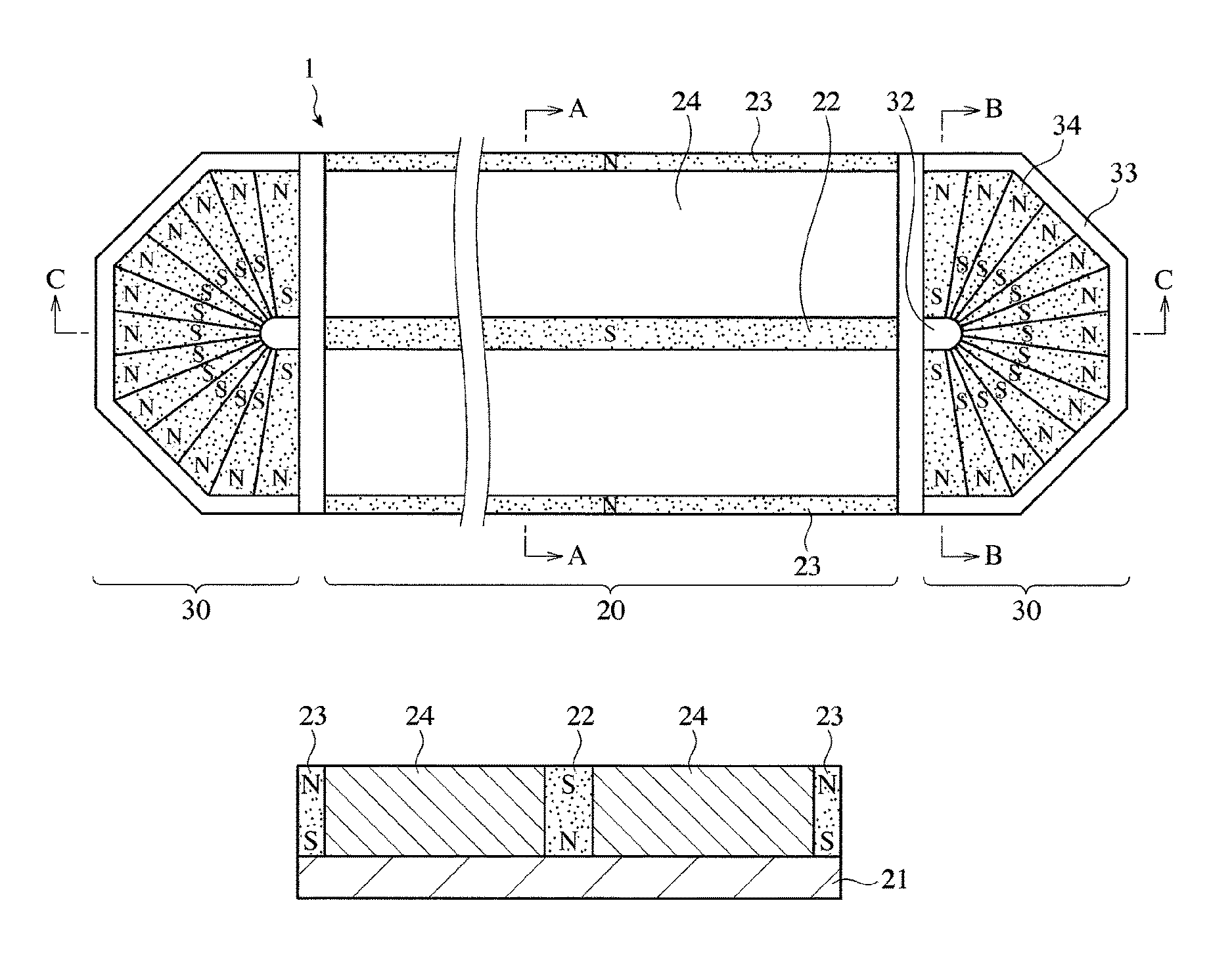Magnetic-field-generating apparatus for magnetron sputtering
a magnetron sputtering and magnetic field technology, applied in vacuum evaporation coating, plasma technique, coatings, etc., can solve the problems of rapid erosion in the corner portions, adversely affecting the control equipment of the sputtering apparatus disposed on the opposite side of the target, and insufficient improvement, so as to reduce the magnetic field leakage and influence the sputtering apparatus. small
- Summary
- Abstract
- Description
- Claims
- Application Information
AI Technical Summary
Benefits of technology
Problems solved by technology
Method used
Image
Examples
example 1
[0156]As shown in FIGS. 25(a), 25(b) and 25(c), a linear portion 20 comprising a yoke 21 formed by a steel plate (SS400), and a center permanent magnet 22 and side permanent magnets 23 formed by anisotropic sintered R-T-B magnets (NMX50AH available from Hitachi Metals, Ltd. having a maximum energy product of 50 MGOe or more), and corner portions 30 each comprising a base 31 made of austenitic stainless steel (SUS304), a center magnetic pole member 32 and a peripheral magnetic pole member 33 each formed by a steel plate (SS400), and permanent magnets 34 formed by anisotropic sintered R-TM-B magnets (NMX50AH available from Hitachi Metals, Ltd. having a maximum energy product of 50 MGOe or more) were assembled to produce a magnetic-field-generating apparatus 1, in which W=300 mm, L1=200 mm, L2=50 mm, a=100 mm, b=50 mm, c=20 mm, d=10 mm, e=30 mm, f=100 mm, g=50 mm, h=20 mm, i=10 mm, and j=10 mm. Horizontal and perpendicular components of a magnetic flux density at a height of 20 mm (cor...
example 2
[0158]Points P and Q, at which a perpendicular component of a magnetic flux density on a target surface was zero, were measured along the lines A and D in the same manner as in Example 1, except for changing the arrangement of magnets in each corner portion as shown in FIG. 4 in the magnetic-field-generating apparatus 1 of Example 1 (see FIG. 25). The occupation ratio of magnets in the corner portion, which was a ratio of an area occupied by the permanent magnets to the area of space between the center magnetic pole member and the peripheral magnetic pole member, was 50%. In this structure, points P and Q were 37 mm and 43 mm, respectively, the same as in the magnetic-field-generating apparatus 1 of Example 1.
example 3
[0159]Points P and Q, at which a perpendicular component of a magnetic flux density on a target surface was zero, were measured along the lines A and D in the same manner as in Example 1, except for changing the arrangement of magnets in each corner portion as shown in FIG. 5 in the magnetic-field-generating apparatus 1 of Example 1 (see FIG. 25). The occupation ratio of magnets in the corner portion was 50%. In this structure, the points P and Q were 37 mm and 42 mm, respectively, substantially the same as in Example 1.
PUM
| Property | Measurement | Unit |
|---|---|---|
| magnetic flux density | aaaaa | aaaaa |
| magnetic field | aaaaa | aaaaa |
| magnetic field intensity | aaaaa | aaaaa |
Abstract
Description
Claims
Application Information
 Login to View More
Login to View More - R&D
- Intellectual Property
- Life Sciences
- Materials
- Tech Scout
- Unparalleled Data Quality
- Higher Quality Content
- 60% Fewer Hallucinations
Browse by: Latest US Patents, China's latest patents, Technical Efficacy Thesaurus, Application Domain, Technology Topic, Popular Technical Reports.
© 2025 PatSnap. All rights reserved.Legal|Privacy policy|Modern Slavery Act Transparency Statement|Sitemap|About US| Contact US: help@patsnap.com



